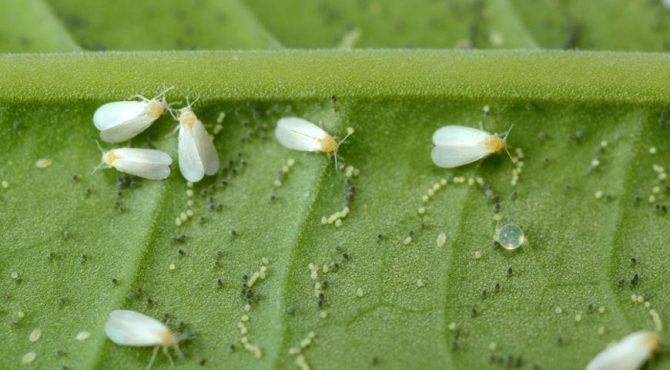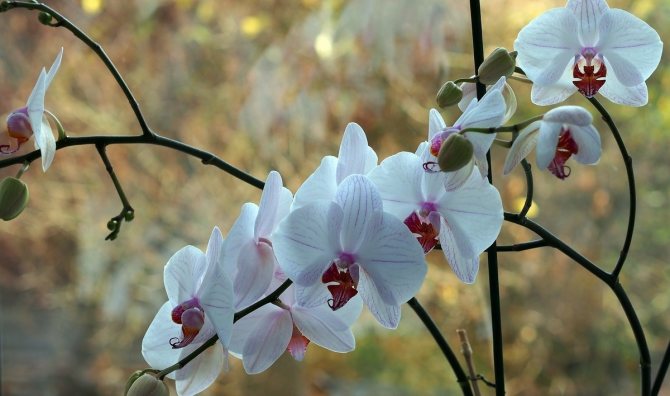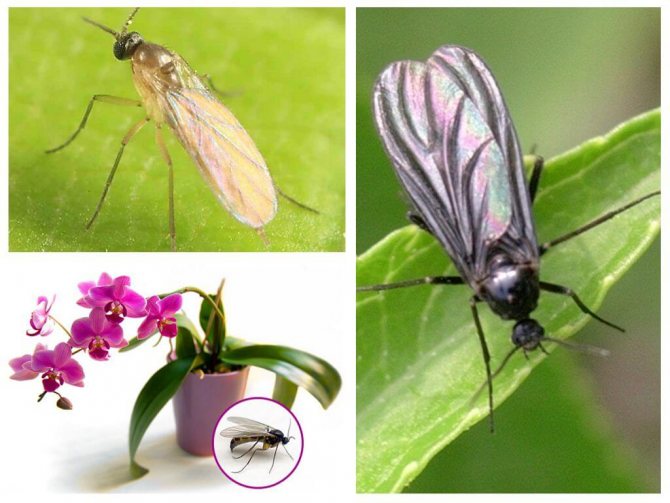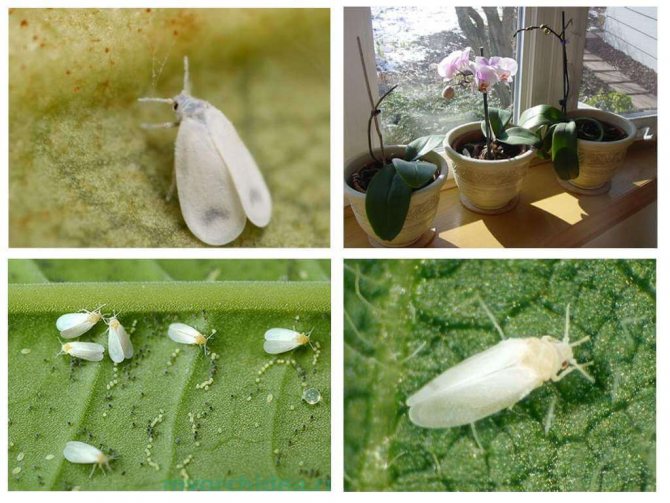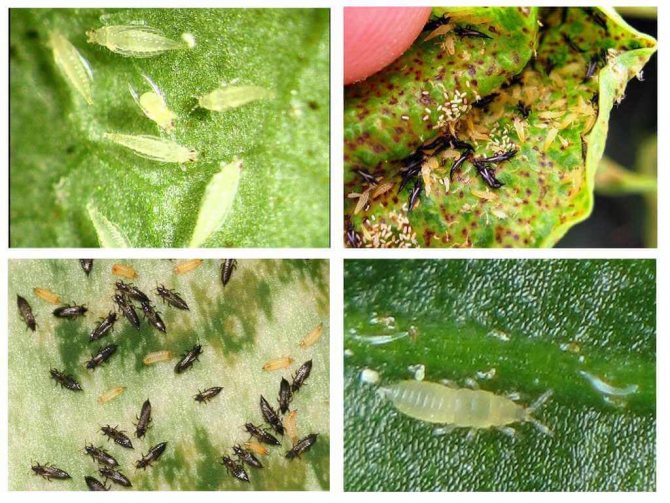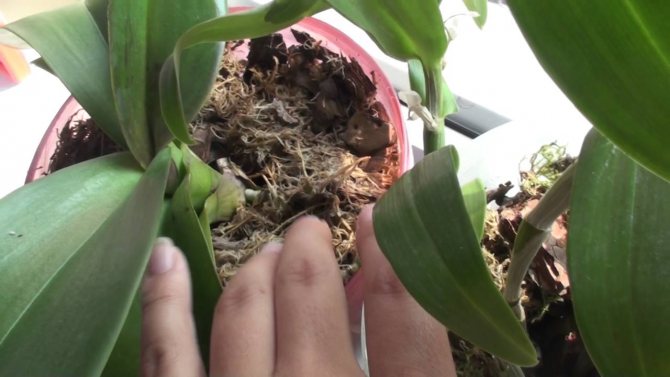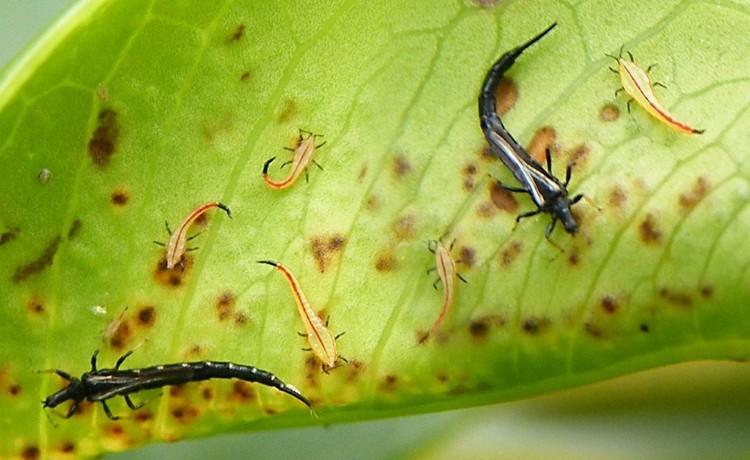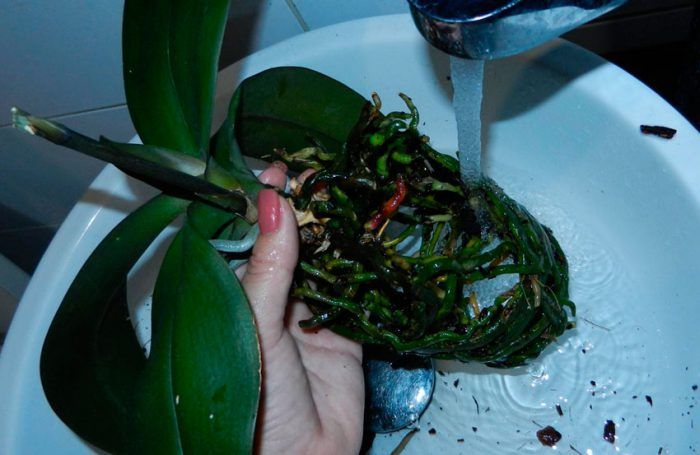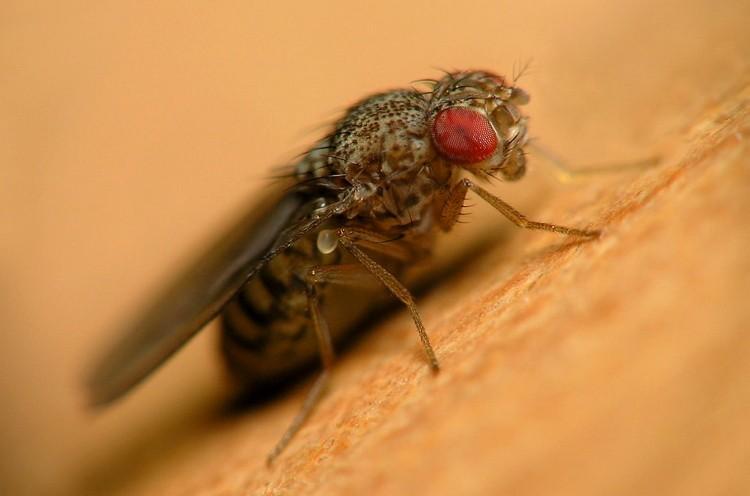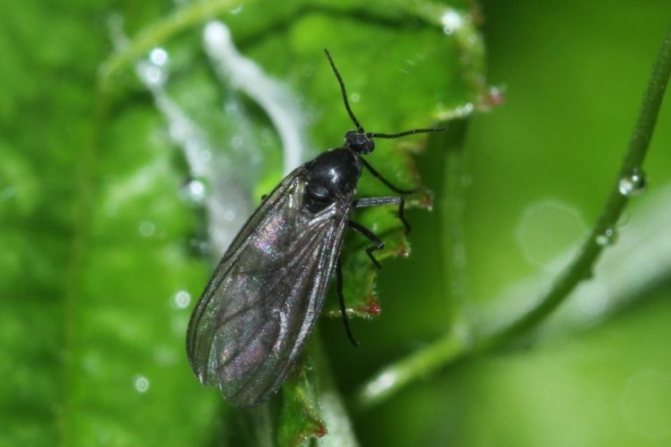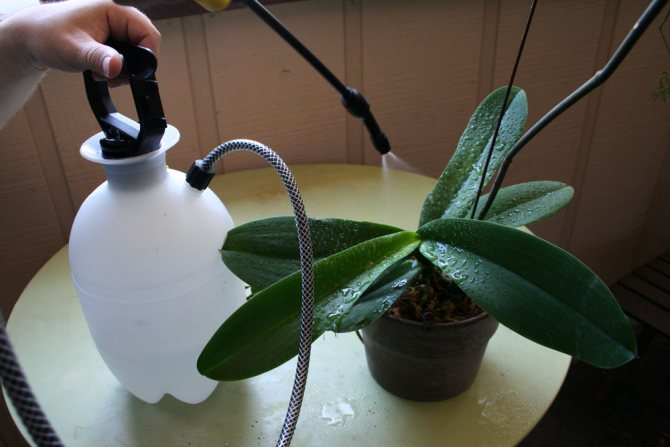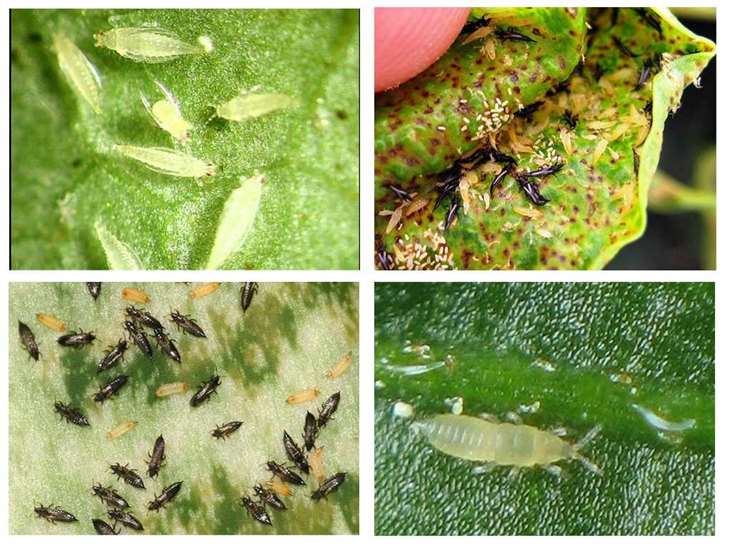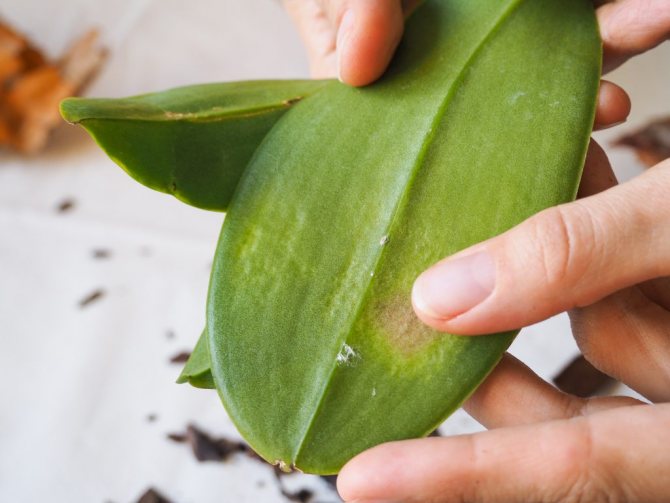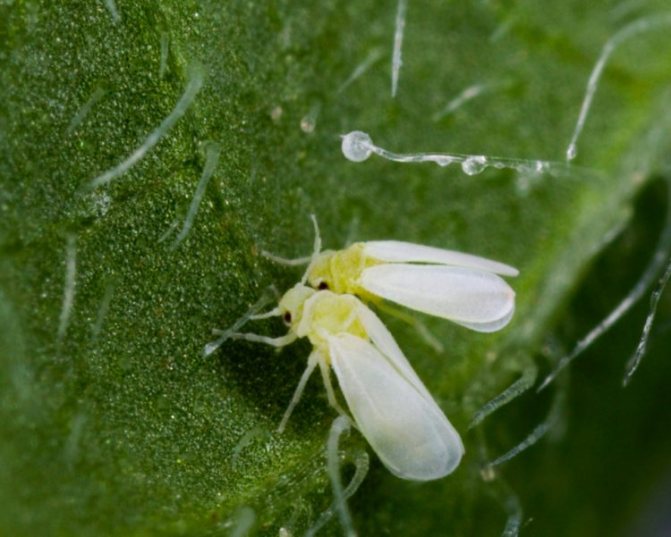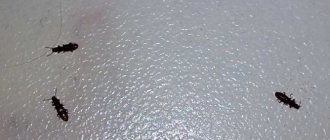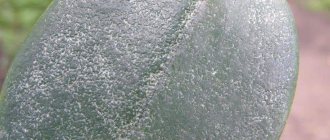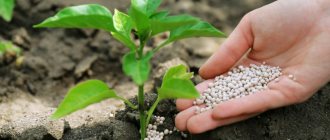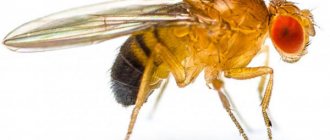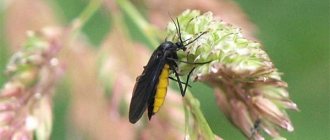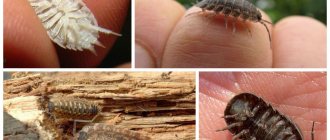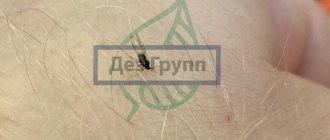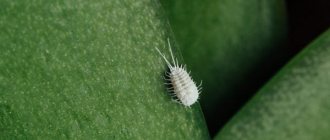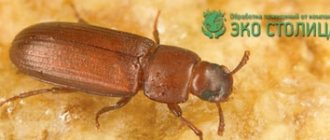A blooming orchid is a real delight, hitting the owner:
- A variety of color shades;
- The magnificence of fairly large flowers;
- And the duration of flowering.
And it seems that the care is being carried out appropriately, the conditions are favorable, but suddenly some small midges appearspoiling the whole picture of splendor.
If you do not take urgent measures, then, in addition to the inconvenience, they are still enough severely harm the plant and may even destroy him.
The main reasons for the appearance of midges
Why did midges appear on the orchid and in its soil? The primary reason for the appearance of different types of midges is high humidity not only ambient air, but mainly soil (substrate). They can fly in from the street or from other indoor plants that require soil or organic matter in the pot at constant humidity.
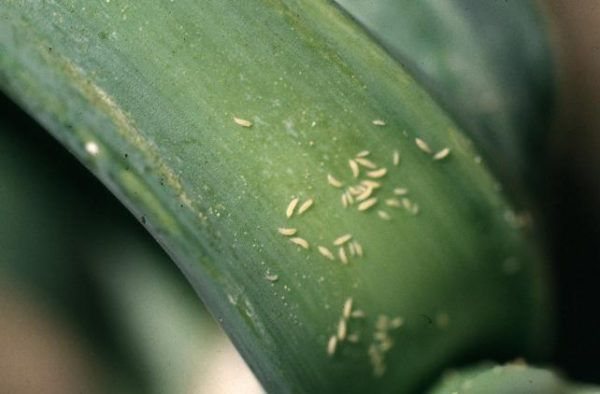
Midges appear on orchids due to high humidity.
Often the reason for the appearance may be a poor-quality soil mixture that has not undergone heat treatment, containing midge larvae, which will quickly begin to settle in other flower pots.
Quite often, using moss to maintain moisture, growers are in no hurry to replace it. Decaying, it is good source of appearance all kinds of flying pests.
The location of vegetables or fruits next to tropical plants causes not only negative consequences for development, but also the appearance of all kinds of insects... And often not harmless.
Prevention of infection
Scabbard on indoor plants - how to fight at home
In order to prevent insects from starting again, some rules should be followed:
- Sprinkle the soil purchased for indoor plants with plenty of water, and then place it in the freezer for several days. During this time, the larvae, if they are in the soil mixture, will die.
- A purchased new flower should not be placed immediately in a room where others are located, but placed in a separate room. If after a month there are no pests on it, you can rearrange it with the rest. However, it is not recommended to keep the entire collection on one windowsill.
- Install mosquito nets on the windows to prevent insects from entering the house from the street.
- Monitor the cleanliness of the room where the orchid stands, discard spoiled fruits and vegetables in a timely manner.
- Before transplanting a plant into them, new pots should be disinfected: rinse with boiling water or rinse with a manganese solution.
Types of these insects
Identification of midges - the main task of the grower is to determine the method of dealing with them:
- Whether it is harmless fruit flies or mushroom mosquitoes;
- Or it is the harmful whitefly thrips.
Sciarids
Soil or fungal mosquitoes of the Sciaridae family - one of the oldest groups Diptera insects. There are more than 20,000 species of this insect in the world. In home floriculture, only three of them are most often found:
- Sciiara;
- Licoriella;
- Bradisia.
Distinguish them to a non-specialist quite difficult... Some are slightly less or more. Some are darker or very slightly lighter. Only under a microscope can you figure out which species the plant has chosen.
In most cases, their appearance is associated with the larvae in the ground.But often adults who flew in through the window individuals lay eggs in moist soil favorable for reproduction.
Attention! If there are conditions for their life, reproduction and nutrition, then it is impossible to get rid of them even with chemical preparations. The place of the dead insects will be taken by the newly arrived ones.
Basic conditions existence and rapid reproduction Sciarid:
- Rapidly decomposing organic matter;
- And constantly wet soil.
Small, dipteran (wingless species are rare) mosquito with:
- Narrow body and rounded head;
- Very small in size, depending on the species - 0.5-2 mm.
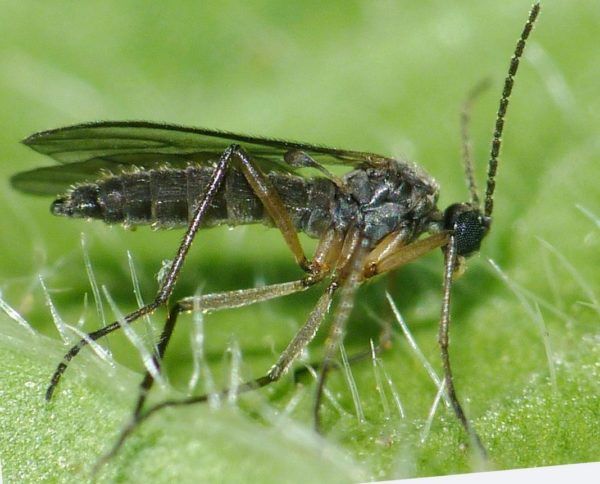

For the orchid, it is not the sciarids themselves that are dangerous, but their larvae.
The legs and abdomen are usually gray or black in color. The underdevelopment of the oral organs does not make it possible for adults to eat, so they do not pose a danger to the plant.
The danger is represented by their larvae, which appear after a few days, as the female lays eggs in moist soil. The larvae are worm-shaped, from 2 to 10 mm in length.
Translucency, translucent intestines and black head are distinguishing feature from annelids, also preferring a moist substrate with organic elements.
It is the larvae that harm the orchid, eating roots... The foci of damage begin to rot rather quickly, as a result of the putrefactive process over time, covers the entire root system, which can lead to the death of the plant.
Sciarid larvae cannot stand overdried substrate... If they are removed from the substrate, then they die in a matter of minutes.
Whiteflies
Many growers notice that small white midges have started up in the ground.
It's snow white, more resembling a miniature moth, the mole-like whitefly, poses a real threat to mainly thin-leaved plants, but large colonies do not disdain fleshy, succulent shoots.
Whitefly body:
- White or yellow-red;
- Only up to 3 mm long (usually about 1.5 mm) .;
- 4 wings at rest fold into a roof-like appearance.
Reproduction is frequent and very fast. The emergence of a generation of the same age, from eggs to an adult, takes only a little over a month.
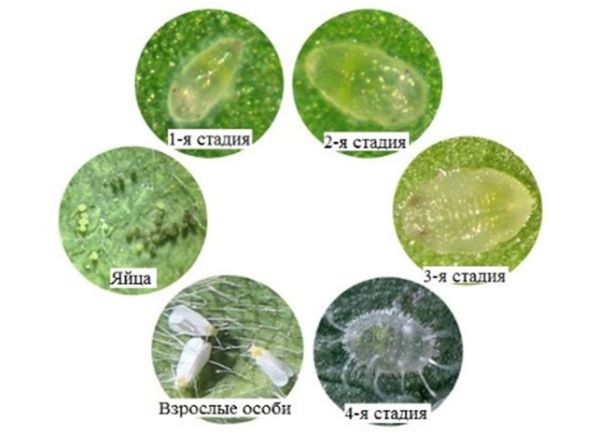

Development stages of the whitefly.
Females usually lay eggs on the inner side of young leaves in groups, in the form of a ring up to 20-25 pieces. Fecundity of females is very high - 130-250 eggs. The larvae emerging from the eggs at first have good mobility. Having found a convenient place to eat, they suck and draw juices from it.
My favorite place is inner side of the sheet plate... During growing up, their bodies are covered with a wax bloom, with three molts. After the third molt, they stop moving and feeding, entering a transitional phase of maturation.
It is this period, when the skin hardens, and the larva turns into a "false cocoon", is out of reach for almost any drug, even systemic action. Therefore, the destruction of the colony requires complex, repeated and, moreover, systemic processing at regular intervals.
Sucking the juice from the leaves, stems, damaged plant parts:
- Turn yellow;
- And dry up.
At the location of the colony of larvae and adults, sugary secretions remain, stimulating the appearance of a sooty fungus, bringing another harm to the orchid.
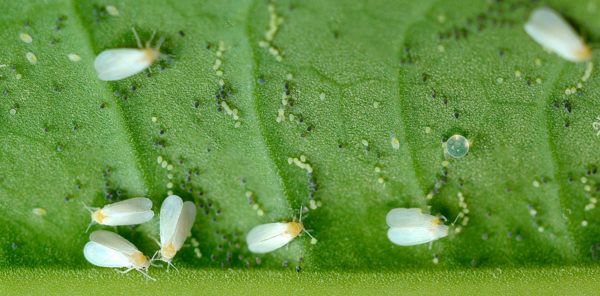

Whiteflies reproduce very quickly.
Important! Whiteflies are often carriers of viral infections.
Like most parasites, they prefer places:
- Warm;
- With high humidity;
- Unventilated.
Their appearance in the apartment can happen:
- Open windows;
- Or with the advent of a new plant.
Fruit midges (fruit flies)
Another representative of insects that can appear on an exotic flower is fruit fly from the squadron Diptera.
The tropical beauty does not pose any harm and special danger, but its appearance means the beginning of putrefactive processes in the substrate. In addition, the appearance of fruit flies in the apartment is not very pleasant.
Small in size, with a short life cycle, flies, eat rotting products:
- Moss;
- Leftover tea leaves;
- Fruits;
- Vegetables.
When midges appeared in the ground, they cause great inconvenience to flower growers by their presence. The female can lay more than 400 eggs, of which literally in a day larvae appear, and a week later, adults.
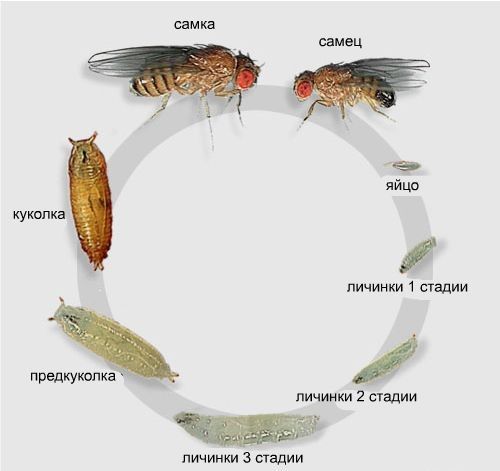

Stages of development of fruit flies.
And no matter how harmless the fruit flies are, it is necessary to fight with them.
Thrips
One of the most dangerous for any plant, a species of insect parasites. Very small, on average 1-2 mm, with a piercing-sucking type of mouth apparatus. The slender jogging feet have a tooth and a suction bubble-like device.
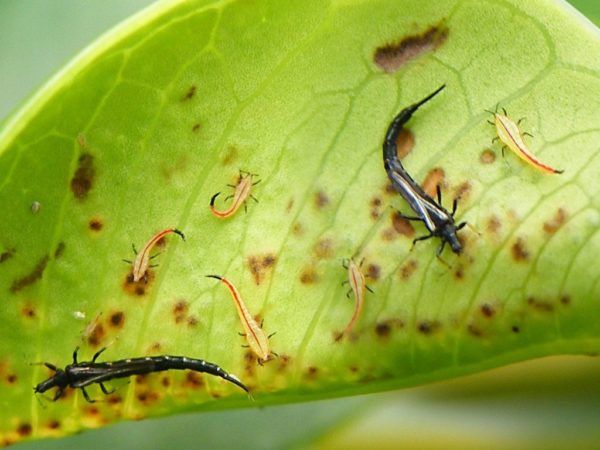

Thrips are one of the most dangerous plant pests.
The main food of thrips is plant cell sap... Reproduction and development is divided into several stages. A female can reproduce about 10-12 generations per year. Eggs are laid in the tissue of leaf plates, where they go through more than one stage of development:
- After the eggs, the larvae appear;
- Then protonymphs and nymphs;
- And only then does an adult appear.
Damage caused by a pest similar to spider mite infestation... Air enters the puncture of the leaf tissue or other part of the orchid and the decay process begins:
- The color of the leaves changes;
- A silvery film appears;
- The leaf turns yellow and falls off.
Orchid attacked by thrips needs to isolation and early treatment from such harmful parasites that can destroy the plant.
Thrips do not tolerate high humidity.
Dampness and mold
Fungus insects are not the most common pest of indoor plants. They are often confused with fruit flies (Drosophila), although our mosquitoes have a darker color. While fruit flies fly near fruits and rotten foods, sciarids appear near wet soil, sewers, and drains.
Fungus mosquitoes are attracted to CO2 (carbon dioxide), which is why they fly right in the face.
The adults of these midges are 1-2 millimeters long, thin and look like very small mosquitoes. These tiny black insects seem harmless, because they just fly around the plant.
Mold in the substrate
But, while adult insects sit on the leaves of the Orchid, without harming it, their larvae feed on juices from the thin root hairs of the flower. This leads to yellowing of the leaves and weakening of the plant. They can also damage the fragile roots or stems of the plant, making it vulnerable to rot and infection.
The easiest way to avoid these gnats is to properly water your Orchid. It is excessive watering and poor drainage that contribute to the appearance of fungi, mold spores and rotting, which attracts fungus midges.
Midges have started up in the orchid: what to do?
No use of chemicals
How to get rid of orchid flies? Depending on the type and number of flying pests methods of struggle are chosen with them.
If in the fight against fruit flies or whiteflies (not always) you can do with folk remedies, then with the appearance of thrips, spider mites, some folk remedies will not be enough.
As preventive measures, they are possible and will be effective, but when colonies have appeared, and especially when eggs have already been laid, they will be effective only chemicals.
Sometimes it is enough to deprive them of their living conditions and food so that they simply disappear from the room. But this method it is not always possible to implement.
When the first whiteflies appear, you can rinse the sheet apparatus within a week under running water, thereby preventing insects from laying eggs, washing them off. Or wipe the entire ground part of the plant with a prepared soapy solution.
In the presence of a spider mite using the current method is an:
- Rubbing cyclamen tubers with infusion;
- Or rubbing alcohol.
Attention! The leaf apparatus and other parts of the plant in some orchids have a negative attitude to the effects of alcohol, thereby getting a burn.
Thrips do not tolerate:
- Onion infusion;
- And olive oil.
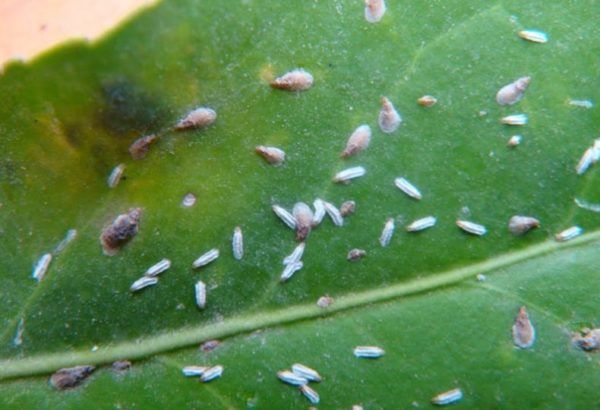

Each type of midge must be fought in different ways.
How effective it is depends on the spread of the parasites. Experienced florists often use leaf shine spray, a cover that thrips and spider mites do not like.
The disadvantage of a spray is that it significantly complicates the processes of photosynthesis.
Also, do not forget about the physiological characteristics of pests. Guaranteed no midges is an:
- Adequate conditions;
- Lack of food;
- Good immunity;
- And timely preventive treatment.
Velcro and traps
The effect of traps and stickies is especially effective when whitefly is present on the plants. Bright yellow or orange colors attract their attention... Cardboard of this color, smeared with a sticky substance, is able to lure most of the insects in a day.
Thrips are also good for sticky tapes, only not yellow... Some flower growers recommend using blue saucers filled with water. Apparently, the blue color lures the parasites.
It must be remembered that such methods of struggle effective in:
- Small (initial) appearance of midges;
- And in the stage when they fly.
When fighting eggs and larvae, they are ineffective.
Scare away (citrus, garlic, lavender)
Some insects intolerant of essential oilssecreted by some vegetables or fruits. But also the plant itself responds poorly to such discharge.
Lemon or other citrus zest, dug into the substrate, has a deterrent effect on thrips. Or, you can use a garlic decoction applied with a cotton swab to the sheet plates.


Midges are strongly discouraged by the smell of citrus fruits.
According to experienced orchid growers, such methods of dealing with midges on orchids are ineffective. If they have any effect, then only frightening or as a preventive measure, when insects are in units.
Using chemicals
Below you will find out how to treat the plant to combat annoying midges.
Bazudin
An insecticide, the main active ingredient of which is diazinon... The action of this drug is directed in 3 directions:
- Contact;
- Intestinal;
- And translaminar (it penetrates well into plant tissues).
Effective when applied in home floriculture against the larvae of mushroom gnats and whiteflies in the soil. It is mainly used to treat pest-infested soil.
Has a significant drawback. On contact with water, during watering or high humidity, a strong, unpleasant odor appears, which is especially felt in a confined space, which is the apartment or room.
Thunder-2
How to get a midge out of an orchid quickly? With a strong colonization of the soil by midges and their larvae, folk remedies will not help. Probably, flower growers consider one of the best means biological preparation Grom-2.
It most effectively destroys the larvae of soil flies. Thunder duration designed for a month.
Advice! After applying Thunder-2 on orchids, watering should be stopped for 3-4 days.
Unlike other chemicals, Thunder-2 does not harm the plant and has a 4th hazard class for humans and animals. Following simple safety rules, he will not harm the inhabitants of the apartment.
Actellic
Insectoacaricide of unsystematic action. The action of the tool is based in direct contact with the pest.
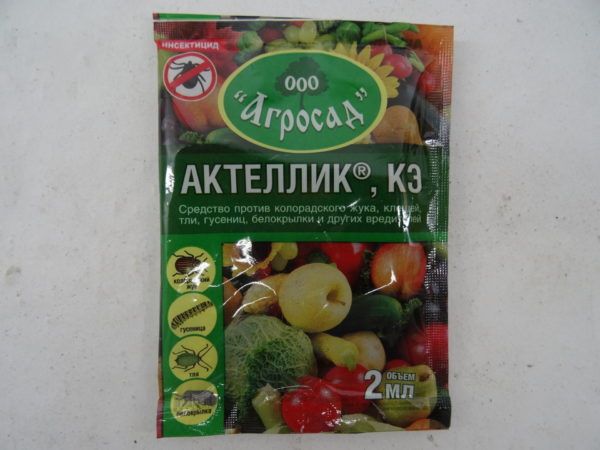

Actellic helps to block the work of enzymes in pests.
Once in the body of the parasite, Actellik blocks the work of enzymesresponsible for neuromuscular transmission of impulses. Having accumulated in the body, all vital functions of the body are disrupted and poisoning occurs, followed by death.
Another positive characteristic of the drug is its fumigant effect, which makes it possible to fight insects on the inside of the leaf plates. He showed himself well in the fight:
- With whitefly and its larvae;
- And also when killing thrips.
Acts almost lightning fast. Midges perish within minutes. Substances contained in the preparation not addictive to it... But nevertheless, experienced orchidists recommend combining Actellik with other means of struggle.
Recommended Actellik to use at home only as a last resort because of its toxicity and unsafeness to others. In a closed space, it is better to do with other means or after processing, not to be in the room for some time and ventilate it well.
Fury
An insecticide belonging to the class of synthetic pyrethroids. Effective against a large number of pests. The advantages of the drug are:
- Broad action on various types of parasites;
- Does not cause resistance;
- Not phytotoxic;
- Resistant to high temperatures;
- Safe for the environment;
- Cost effective.
Reliably protects for two weeks, after which, if necessary re-processing required... Waxed whitefly larvae do not respond to Fury, so re-treatment helps to destroy them at a later stage of development.
Aktara
Systemic insecticide, with the active chemical thiamethoxan. Recommended to fight with soil pests... Experienced orchidists recommend the drug in the fight against thrips and whitefly. It is used for spilling soil and spraying on a sheet. In combination with Aktellik, the process of getting rid of pests is significantly accelerated.
Unlike Aktellik, it is not so toxic, which makes it safer to use in an apartment.
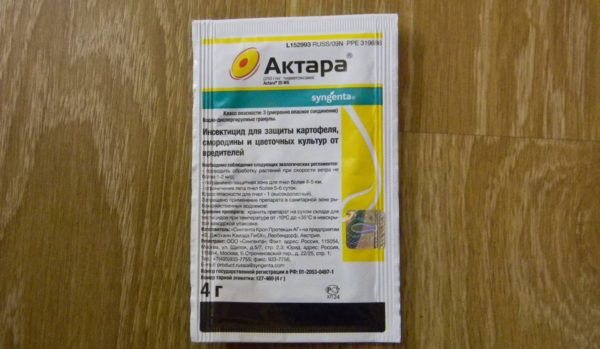

Aktara effectively and quickly destroys pests.
Dignity:
- High-speed performance;
- Efficiency;
- Duration of action.
disadvantages:
- Dangerous for animals;
- When processing, personal protective equipment is required;
- There are many fakes on sale.
Raptor
Insecticidal agent against flying insect pests. By acting on the nervous system, it causes paralysis and death. The advantages lie in the rapid destruction of midges by spraying with aerosol.
disadvantages:
- Dangerous for animals, humans;
- And ventilation of the room is required after processing.
Attention! The use of chemicals causes a negative effect on the young parts of the plant.
Traditional methods
Many beginner flower growers ask the question: how to get rid of midges at home? There are several simple and safe folk methods fight against midges, which often help rid the plant of these annoying, and sometimes very harmful, parasites.
Mustard
there is two ways application of dry powder of ordinary mustard:
- 1 teaspoon of dry powder is diluted in a glass of water. This solution is poured over the substrate. After a while, the larvae, usually located at a depth of no more than 5 cm, will disappear;


Mustard powder is good at destroying midges on an orchid. - The surface of the soil is sprinkled with a thin layer of mustard. The procedure is carried out every 5-7 days until the midge or other parasites disappear completely.
River sand
Decent reviews from florists has river sand... Well calcined in the oven for disinfection, sand is sprinkled on top of the soil. If necessary, the procedure should be repeated several times.
Potassium permanganate
Watering with a weak solution of potassium permanganate carried out as needed for 30-50 days. Potassium permanganate dries up the larvae in the soil. It is important to use a weak solution so as not to burn the young orchid roots.
How to get rid of pests at home
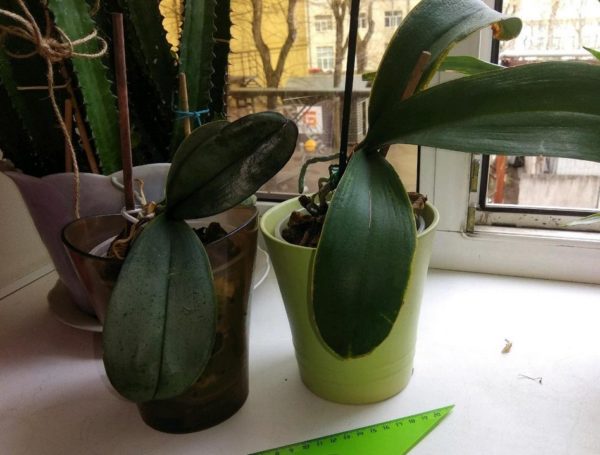

If midges have already been found in orchids, how to get rid of it can be a serious problem. You can take out midges in the following ways:
- using folk recipes;
- horticultural chemicals;
- by changing the ground.
Note.
When midges start in the orchid, then first of all, they examine the foliage and soil. This should be done immediately, until harmful insects have caused irreparable damage to the bark of the flower.
If midges start up, then initially, they need to be identified, and then, the larvae, adults should be removed and the reasons that caused them should be overcome. It is possible to fight various pests with improvised means. Most orchids, like any flower, are susceptible to attacks by various insects and not all growers trust new-fangled chemical compositions. If black midges appeared in orchids or white midges overpowered, then it is important to immediately process the flower. For certain reasons, housewives are trying to lime pests that have wound up in the soil of the orchid with natural compounds.
Small midges in orchids are afraid of the following home solutions:
- Pass two cloves of garlic through a garlic press and cover with hot water, leaving after that for 4-5 hours. Wipe the foliage on all parts with a solution.
- Dissolve a tablespoon of sunflower or olive oil in half a liter of clean water and spray.
- Soap solution - add a teaspoon of liquid soap to a glass of water and wipe the leaf surface.
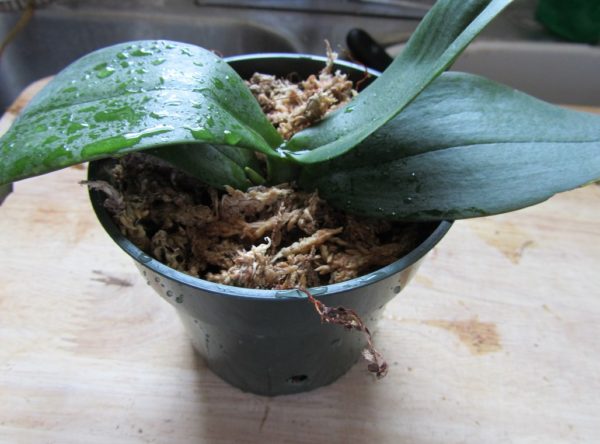

The last recipe can also be used as a prophylaxis, so that small midges do not start. You can make this formulation and apply as soon as one of the symptoms of the disease appears.
Flowers can be treated with chemical compounds. The most suitable are:
- Fundazol - protects against all types of dew, mold, rot.
- Fitosporin - protects against diseases of a bacterial and fungal nature, can be used for spraying and processing damaged leaves. Use only liquid form.
- Antibiotics
- Vitamin B.
- Urea.
- Chlorhexidine.
- Iron chelate.
- A mixture of succinic acid and glucose.
- Epin.
- Zircon, Aktelik, Fitoverm, Appolo.
- Fertilizers of the nitrogen type.
- Based on a mixture of phosphorus and potassium.
Attention!
Each fertilizer must be applied carefully so as not to ruin the flower.

